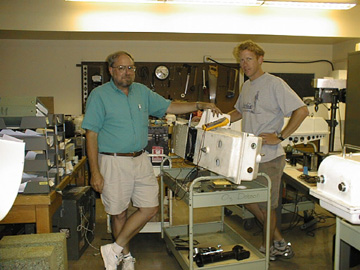5 August, 1998
Wednesday, August, 5th, 1998
Dobson Spectrophotometer Ozone Measurements
No rain in Boulder today. Bright sunshine: the ideal day to get
introduced to the Dobson Spectrophotometer and Bob Evans , the Dobson
specialist at NOAA. in Boulder. This is also the World Calibration
Center for Dobson Instruments. Bob was going to explain his work and the
instrument to me at 10 a.m. and several people were going to join me in
this technical introduction: Bryan Johnson whom I introduced earlier and
who set up the meeting and Joel Michalski and Andy Clarke. Joel and Andy
will winter over at the South Pole and they will be there during my
stay. They are going to be the technical support staff for NOAA and need
to know all instruments, how they work, and how they can be repaired.
The Dobson Spectrophotometer is located in a dome on the roof of the
NOAA building.
The measurements done with the Dobson are one of the ways to
measure total ozone. Total ozone means the total amount of ozone above a
certain point linear to the sun. This means that the "Dobson" can not be
used at the South Pole in the winter time. It will be used once the sun
is at a certain angle above the horizon, at the beginning of October. It
will be used when we will be at the South Pole in January.
Where does the name "Dobson" come from?
G.M.B.Dobson used a spectrophotometer and discovered by 1930 that total
ozone values depend on the location, season, weather, and time of the
day. This type of spectrophotometer was further developed and also used
to trace stratospheric air masses for weather forecast Before World War
II, 9 - 12 instruments were operating in the world. The design of the
instrument has not changed since 1947 except for the electronics. It
looks like a two meter long white submarine; the view finder being the
actual sun-finder.
After the International Geophysical Year (IGY)in 1957, some more
instruments were build and the first "Dobson" was installed at the South
Pole. At this time, 120 Dobson Spectrophotometers are in operation
around the world.
How does it work?
The principle is absorption of UV light, so the "Dobson" works only in
sunlight or moon light The measurements are done with different
wavelength between 305nm to 340nm. Since ozone absorbs UV rays, the
measurements can be converted into total ozone in Dobson units.
These measurements are done frequently at many locations in the world
and keep track of any seasonal ozone changes at a certain location in
the world.
Interesting fact: Oxygen absorbs short - wavelength light greatly from
75 to 250 nm. Above that wavelength, the ozone molecules absorb the
dangerous UV light.
Check out the web site: http://www.cmdl.noaa.gov/dobson/

The photo shows Andy (right) and Bob (left) with a Dobson spectrophotometer in the middle. The Dobson measures total ozone values at a parcticular time.
Contact the TEA in the field at
.
If you cannot connect through your browser, copy the
TEA's e-mail address in the "To:" line of
your favorite e-mail package.
|
